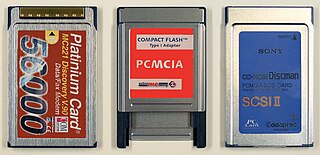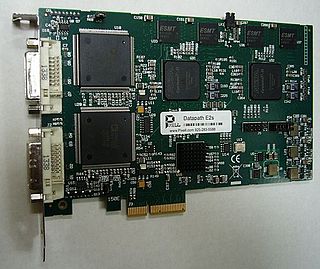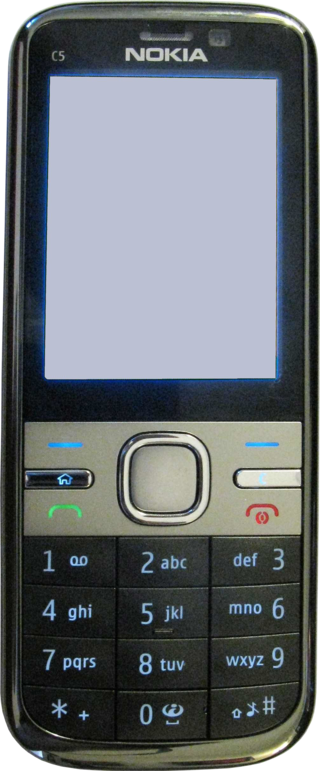
A motherboard is the main printed circuit board (PCB) in general-purpose computers and other expandable systems. It holds and allows communication between many of the crucial electronic components of a system, such as the central processing unit (CPU) and memory, and provides connectors for other peripherals. Unlike a backplane, a motherboard usually contains significant sub-systems, such as the central processor, the chipset's input/output and memory controllers, interface connectors, and other components integrated for general use.

A sound card is an internal expansion card that provides input and output of audio signals to and from a computer under the control of computer programs. The term sound card is also applied to external audio interfaces used for professional audio applications.

PC Card is a parallel peripheral interface for laptop computers and PDAs.

In computing, an expansion card is a printed circuit board that can be inserted into an electrical connector, or expansion slot on a computer's motherboard to add functionality to a computer system. Sometimes the design of the computer's case and motherboard involves placing most of these slots onto a separate, removable card. Typically such cards are referred to as a riser card in part because they project upward from the board and allow expansion cards to be placed above and parallel to the motherboard.

A graphics card is a computer expansion card that generates a feed of graphics output to a display device such as a monitor. Graphics cards are sometimes called discrete or dedicated graphics cards to emphasize their distinction to integrated graphics processor on the motherboard or the CPU. A graphics processing unit (GPU) that performs the necessary computations is the main component in a graphics card, but the acronym "GPU" is sometimes also used to erroneously refer to the graphics card as a whole.

S-Video is an analog video signal format that carries standard-definition video, typically at 525 lines or 625 lines. It encodes video luma and chrominance on two separate channels, achieving higher image quality than composite video which encodes all video information on one channel. It also eliminates several types of visual defects such as dot crawl which commonly occur with composite video. Although it improved over composite video, S-Video has lower color resolution than component video, which is encoded over three channels.

A memory card is an electronic data storage device used for storing digital information, typically using flash memory. These are commonly used in digital portable electronic devices. They allow adding memory to such devices using a card in a socket instead of protruding USB flash drives.
The Minnesota Experimental City (MXC) was a proposed planned community to be located in northern Minnesota. Proposed and studied beginning in the 1960s, it would have been constructed as a public–private partnership. In contrast with many of the model cities of the time, the MXC was to be experimental, trying new things rather than proposing to select from the best of the existing practice. The project was initiated and directed by renowned scientist and University of Minnesota dean Athelstan Spilhaus, and reflected the confidence of that era in the ability of science and technology to solve the world's problems -- "If we could send a human into space, we could do anything" -- and concern that existing cities were failing, blighted by crime, decay and exodus of the well-off to the suburbs.

The Nintendo e-Reader, commonly abbreviated as e-Reader, is an add-on manufactured by Nintendo for its Game Boy Advance handheld video game console. It was released in Japan in December 2001, with a North American release following in September 2002. It has an LED scanner that reads "e-Reader cards", paper cards with specially encoded data printed on them.

A TV tuner card is a kind of television tuner that allows television signals to be received by a computer. Most TV tuners also function as video capture cards, allowing them to record television programs onto a hard disk much like the digital video recorder (DVR) does.

Most Extreme Elimination Challenge (MXC) is an American comedy television program that aired on TNN/Spike TV from April 19, 2003 to February 9, 2007. It is a re-purpose of footage from the Japanese game show Takeshi's Castle, which originally aired in Japan from 1986 to 1990. The re-purposed MXC created a completely new premise, storyline, and characters, with two teams competing against each other à la a typical team sports broadcast and players trying to win points for their teams by surviving through different challenges. In the original program the Count and his underlings would follow the progress of the players as they moved through the course. In the re-purpose Count Takeshi became veteran network announcer Vic Romano and the Count's flunky became young upstart Kenny Blankenship.

Device Manager is a component of the Microsoft Windows operating system. It allows users to view and control the hardware attached to the computer. When a piece of hardware is not working, the offending hardware is highlighted for the user to deal with. The list of hardware can be sorted by various criteria.

The feature connector was an internal connector found mostly in some older ISA, VESA Local Bus, and PCI graphics cards, but also on some early AGP ones. It was intended for use by devices which needed to exchange large amounts of data with the graphics card without hogging a computer system's CPU or data bus, such as TV tuner cards, video capture cards, MPEG video decoders, and first generation 3D graphic accelerator cards. Early examples include the IBM EGA video adapter.

A frame grabber is an electronic device that captures individual, digital still frames from an analog video signal or a digital video stream. It is usually employed as a component of a computer vision system, in which video frames are captured in digital form and then displayed, stored, transmitted, analyzed, or combinations of these.

DMS-59 was generally used for computer video cards. It provides two Digital Visual Interface (DVI) or Video Graphics Array (VGA) outputs in a single connector. A Y-style breakout cable is needed for the transition from the DMS-59 output to DVI (digital) or VGA (analogue), and different types of adapter cables exist. The connector is four pins high and 15 pins wide, with a single pin missing from the bottom row, in a D-shaped shell, with thumbscrews. As of December 2020, this adapter cable was listed as obsolete by its primary vendor Molex.
Audio connectors and video connectors are electrical or optical connectors for carrying audio or video signals. Audio interfaces or video interfaces define physical parameters and interpretation of signals. For digital audio and digital video, this can be thought of as defining the physical layer, data link layer, and most or all of the application layer. For analog audio and analog video these functions are all represented in a single signal specification like NTSC or the direct speaker-driving signal of analog audio.

The Nokia C5-00 is the first in the new Cseries of Nokia phones, announced March 2010. The C5-00 is a smartphone with messaging and social networking features, including, for example, Facebook and Flickr applications. The C5-00 allows multitasking and has a 2.2-inch (56 mm) display and a 5.0-megapixel camera. It also includes GPS and a free navigation courtesy of Ovi Maps. It runs on Symbian OS with S60 3rd Edition Feature Pack 2.
Various accessories for the PlayStation 2 video game console have been produced by Sony, as well as third parties. These include controllers, audio and video input devices like microphones and video cameras, and cables for better sound and picture quality.

The Nokia Lumia 730 is a smartphone developed by Microsoft Mobile and branded as "Nokia" that initially runs Microsoft's Windows Phone 8.1 operating system. It was announced on September 4, 2014 at Internationale Funkausstellung Berlin and released in October 2014. It is a successor to the 2013 Nokia Lumia 720 and marketed as a selfie phone.















